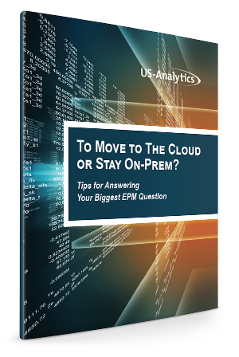There are a lot of possibilities for the future of your Oracle Financial Close tools. You could upgrade to 11.1.2.4, move to the cloud, or wait until 2019 to upgrade when 11.2 comes out. With so many different options, you’re bound to get overwhelmed, especially when you’re talking about tools to help with your integral finance operations.
In this blog post, we’ll cover new functionality and features as well as what’s coming soon to on-premises Hyperion Financial Management (HFM) and Oracle’s Financial Consolidation and Close Cloud Service (FCCS).
Hyperion Financial Management (HFM)
There are many loyal HFM users out there. With Oracle’s push to the cloud, the future of on-premises Hyperion applications was unclear for a while. Loyalists can rest assured that HFM isn’t going anywhere and it might even be time to invest or keeping investing in HFM.
HFM 11.1.2.4
If you’re on a version before 11.1.2.4, you’re definitely missing out on some functionality. This version’s performance is 2-5 times faster than prior releases, according to Oracle. You gain features like multi-score scaling for consolidations, increased user interface responsiveness, centralized data retrieval, and much more.
Several patch updates have already occurred for HFM 11.1.2.4 (.101, .103, .201, .204). These updates included:
- Stability and fixing of critical journal bugs
- Solaris support
- Copy/App support
- Consolidation performance and stability
- Start-up options
- Security class access
- DB connections leak
- Consolidation scheduling enhancement
- EAExtract simplified setup
Patch update 11.1.2.4.200 is available now. With this update, you get:
- Journals workbench
- HFM insights
- Rules profiling
- Chart/graphs – Form/grids
- Import application
- DB hardening – RAC and network connectivity
The next two patch updates are 11.1.2.4.250 and 11.1.2.4.300. Version .250 will include automatic consolidations that will utilize your hardware during non-peak hours. You’re also able to turn it off whenever you want and you’re able to configure when to consolidate and where to consolidate.
Version .250 also comes with data insights. This functionality will help you monitor your application and system to act before issues arise. Data insights give you statistics shown on data tables that are sorted by scenario and year. You can also see the number of records that include the following information:
- Invalid data
- Zero value
- Foreign currency data
- Input data
- Calculated data
With version .300, you can look forward to expanded dashboards, archiving and deleting unwanted data, performance improvements, and integration with FCCS.
HFM 11.2
In 2019, Oracle will release Hyperion 11.2. We still don’t know everything about HFM 11.2, but the future looks bright.
So far, we know HFM 11.2 will include:
- Simplified user interface uptake
- Web-based metadata editor
- Simulated posting/consolidation
- Entity hierarchy for ICP dimension
- Enhanced integration with EPRCS & BICS
- Customer-requested enhancements
- FR replace system reports
- Matrixed security
One thing Oracle has stressed is that they’re going to be listening to current customers for what they want to see in the next version. So, if you don’t have HFM now, it’s a good time to get it. You’ll be ensuring that Oracle considers what you want to see in the next version.
Financial Consolidation and Close Cloud (FCCS)
We’ve said it before — FCCS is not HFM in the cloud. The good news is FCCS is updated monthly, which means you’re constantly seeing enhancements and fixes. If you’re curious about these updates, subscribe to our Oracle EPM and BI blog — we’ll keep you posted on new features and enhancements as they are released.
Currently, FCCS includes alternate hierarchy support and the ability to use Close Manager as well as Supplemental Data Manager. You get tight integration with the Financials Cloud, which includes drill back. It also features configurable translations and EPM Connect.
There are a lot of big changes coming up for FCCS. These include:
- Config calculations and consolidation
- Extended custom dimensions
- Advanced consolidations (similar to Managed Ownership in HFM)
- Manage ownership
- Proportional consolidations
- Equity eliminations
- Org by period
- Ownership register
- Platform sizing and performance
- Process control
- Close Manager
- Monitoring tasks
- Cloud integrations
- Supplemental Data Manager
- Integrations to on-premises
Oracle is continuing to work on the future of FCCS. The functionality expected for the not-so-distant future, includes:
- Journal Entry Module
- Integration with any ERP
- Recurring and auto-reversing
- Single-click create
- Advanced consolidation
- Automatic journaling
- Data lineage
- Automatic consolidations
- Event-based alerts
- Integrated XBRL from EPRCS
- HFM Migration Toolkit
There are many pros and cons when it comes to staying on-prem or moving to the cloud. It really depends on what’s right for your organization. Functionality can be improved and applications can be customized, but you should really understand the basic differences between the on-prem and cloud.
To learn more about on-prem vs. the cloud, download the eBook…








